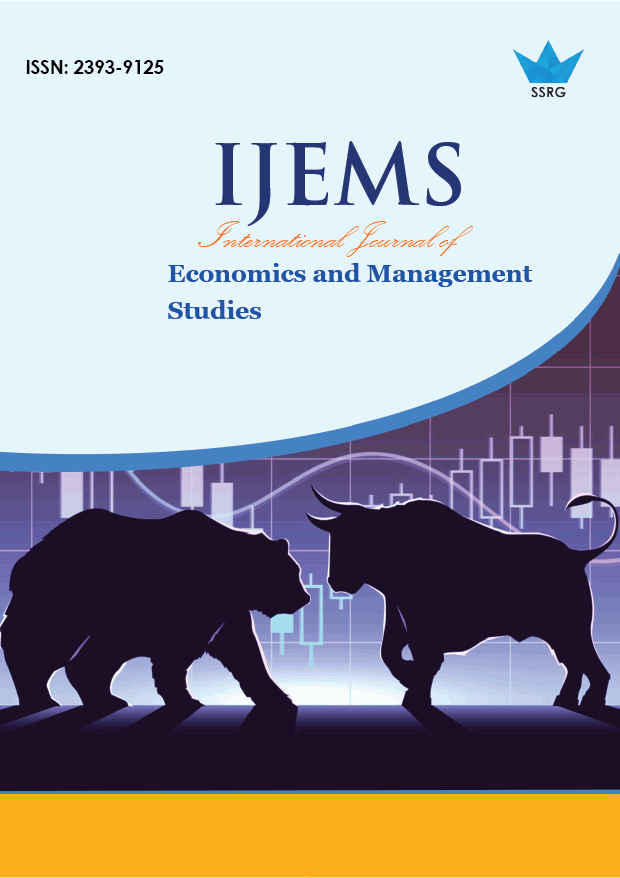Portfolio Selection and Consumption for an Individual Concerning Inflation Risk

| International Journal of Economics and Management Studies |
| © 2021 by SSRG - IJEMS Journal |
| Volume 8 Issue 11 |
| Year of Publication : 2021 |
| Authors : Ming Zhou, Cuixia Chen, Bing Liu |
How to Cite?
Ming Zhou, Cuixia Chen, Bing Liu, "Portfolio Selection and Consumption for an Individual Concerning Inflation Risk," SSRG International Journal of Economics and Management Studies, vol. 8, no. 11, pp. 31-36, 2021. Crossref, https://doi.org/10.14445/23939125/IJEMS-V8I11P104
Abstract:
In this note, we study the optimal consumption and investment problem for an individual who worries about the inflation risk. The value function is taken as the summation of the discounted utility of consumptions before retirement and the discounted utility of terminal wealth at retirement. By employing the dynamic programming principle, we derive the Hamilton-Jacobi-Bellman (HJB) equation satisfied by the value function and then obtain the closed-form solutions of the optimal consumption and investment policies and the value function as well. The results tell us that, for an individual with a relatively high-risk aversion coefficient, he/she will consume less and invest more in a market environment with high inflation risk. The inflation drift does not affect the investment, but it hurts consumption and promotes savings. On the contrary, the volatility of the inflation index has little impact on the consumptions but penalizes or contributes to the investment depending on the sign of the correlation coefficient between inflation risk and financial risk. At last, we believe that different degrees of risk aversion might cause different impacts on the optimal policies for all the economic parameters.
Keywords:
HJB equation, Optimal consumption, Optimal investment, Inflation risk.
References:
[1] Bayraktar, E., Young, V.R., Correspondence between lifetime minimum wealth and utility of consumption. Finance Stochastics, 11(2) (2007) 213-236.
[2] Bayraktar, E., Zhang, Y., Minimizing the probability of lifetime ruin under ambiguity aversion. SIAM Journal on Control and Optimization, 53(1) (2015) 58-90.
[3] Brennan, M.J., Xia, Y., Dynamic Asset Allocation under Inflation. Journal of Finance, 57(3) (2002) 1201-1238.
[4] Browne, S.., Optimal investment policies for a firm with a random risk process: exponential utility and minimizing the probability of ruin. Mathematics of Operations Research, 20(4) (1995) 937-958.
[5] Browne, S., Risk-constrained dynamic, active portfolio management. Management Science, 46(9) (2000) 1188-1199.
[6] Chou, Y., Han, N., Hung, M., Optimal portfolio-consumption choice under stochastic inflation with nominal and indexed bonds. Applied Stochastic Models in Business and Industry, 27 (6) (2011) 691-706.
[7] Fleming, W.H., Soner, M., Controlled Markov Processes and Viscosity Solutions: 2nd edition, Springer, New York, (2006).
[8] Liu, B., Zhou, Ming., Robust portfolio selection for individuals: minimizing the probability of lifetime ruin. Journal of Industrial and Management Optimization, 17(2) (2021) 937-952.
[9] Merton, R.C., Optimum consumption and portfolio rules in a continuous-time model. Journal of Economic Theory, 3(4) (1971) 373-413.
[10] Samuelson, P.A., Lifetime portfolio selection by dynamic stochastic programming. The Review of Economics and Statistics, 51(3) (1969) 239-246.
[11] Shreve, S.E., Soner, H.M., Optimal investment and consumption with transaction costs. Annals of Applied Probability, 4(3) (1994) 609-692.
[12] Zariphopoulou, T., Consumption-investment models with constraints. SIAM Journal on Control and Optimization, 32(1) (1994) 59-85.
[13] Zhou, M., Yuen, K.C., Portfolio selection by minimizing the present value of capital injection costs. Astin Bulletin, 45(1) (2015) 207-238.

 10.14445/23939125/IJEMS-V8I11P104
10.14445/23939125/IJEMS-V8I11P104